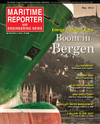
Page 69: of Maritime Reporter Magazine (May 2013)
Energy Production & Transportation
Read this page in Pdf, Flash or Html5 edition of May 2013 Maritime Reporter Magazine
www.marinelink.com 69Gas Detector from Martek Martek Marine released a MED-certiÞ ed por- table gas detector that can be easily and safely recalibrated onboard, providing tamperproof certiÞ cation to meet the many regulations gov-erning detector calibra-tion. Martek?s Marine 4 is supplied with a self-certiÞ cation/calibration station which provides the user with fail-safe automatic bump testing and calibration. The seafarer sim- ply places the Marine 4 gas detector in the station, press a button and waits one minute for the detector to be tested and certiÞ ed, ensuring that calibrations are carried out in a repeatable, tamperproof manner without the possibility of human error. The system then automatically produces a tamper-proof calibration certiÞ cate which is acceptable to clas- siÞ cation societies, oil majors and port state control. Testing programs can be set to meet individual requirements, for example, daily bump tests with weekly calibration and monthly certiÞ cation.Xylem: FerryBox Water Quality Monitor Xylem Analytics UK and Aanderaa Data Instruments launched a new ma-rine water quality monitor, SOOGuard FerryBox, designed to enable wider deployment of water quality sensors on ferries and other marine vessels. A key objective for the SOOGuard design team was therefore to develop a FerryBox that would meet the needs of most vessels whilst requiring the minimum of opera-tional support. The system?s four sensors (conductivity, temperature, optical dis- solved oxygen and chlorophyll a) are Þ t-ted onto the door of a ß ow-through cell, a design that allows simple and rapid cleaning. The sensors are stable and re- quire calibration checks less than once a year in most environments. In addition, ß ow-though cells can be Þ tted to allow for the measurement of additional pa-rameters. The system is complemented by a hull temperature sensor to support the chamber measurements, and a ß ow sensor provides conÞ rmation that the system has a continuous feed of water. While readings are stored locally in the system?s datalogger, communication via GSM, GPRS and Iridium satellite is also possible. Additionally, users can access transmitted data via a web-based inter- face.www.xylemanalytics.co.uk Intellian V100GX VSAT Antenna The new Intellian v100GX three-Axis Ku-Band VSAT communications an- tenna will be seen for the Þ rst time at Norshipping 2013. This antenna is fully prepared for the upcoming Global Xpress (GX) Ka-band broadband service from Inmarsat, and can be upgraded to the service with minimal technical inter- vention. The one-meter v100GX incor- porates a superb dual-band, carbon Þ ber reß ector and tuned radome for consistent service, whether operating on the exist-ing Ku- band or converting to Ka- band when available next year. The antenna can be monitored and controlled remote-ly using the new Aptus PC software, maximizing operational efÞ ciency for service providers, operators and end us-ers. As standard, it is equipped with the patent-pending Intellian Ku-band Global PLL LNB, which is capable of receiv- ing all global satellite signals by using programmable L.O. (Local Oscillator) frequencies. Additionally, the v100GX comes with co-pol and cross-pol func-tionality as standard.EC Gas-Injection Diesel Engine (ME-GI) for Marine UseMitsui Engineering & Shipbuilding Co., Ltd., in cooperation with Mitsui OSK Lines, recently carried out a full-scale demonstrational running of elec-tronically controlled (EC) slow-speed diesel engine for marine use burning natural gas, which is the Þ rst of its kind in Japan and is called ?ME-GI,? and has conÞ rmed that the engine has the same reliability with the oil Þ red diesel engines used for almost all ocean going merchant ships in the world.The test was carried out on the electronically controlled ME-GI of which fuel system was converted to gas burning system from conventional oil burning system temporarily. MES completed its power generation plant with slow-speed gas injection die-sel engine (GIDE) in its Chiba Works in 1994. Through this operation, MES carried out various reliability assessments and accumulated its various operation know-how of such engine. ME-GI, based upon such operational experiences, is a fusion of state-of-the art technologies such as electronic control technology and emission reduction technology. MES exerts its utmost efforts for further adoption of ME-GI to many commercial ships starting with LNG carrier. In July last year, LNG carrier Double Eco MAX, with ME-GI propulsion and with decreased fuel cost and CO2 emission by 30%, was developed by MES and put into market.Through the demonstrational operation, MES has established not only a com-prehensive control system of ME-GI including gas supply system but also the supply system of ME-GI to the customers.MES will also establish a sales system to offer to customers ships with ME- GI propulsion system which are economical and environmentally friendly as well.MR #5 (66-74).indd 69MR #5 (66-74).indd 695/2/2013 10:56:56 AM5/2/2013 10:56:56 AM

 68
68

 70
70
